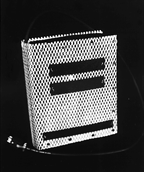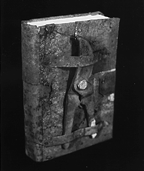|
Readings in Organized Chaos asmax@asuvm.inre.asu.edu
Readings in Organized Chaos, a work in progress, consists of a large library table surrounded by wooden chairs. From the center of the table radiate cables/lifelines, each terminating at a book. The bodies of these tomes are comprised of actual (discarded) books: once containers of knowledge (encyclopedias, dictionaries); of law (law books, driving manuals); of culture (literature and history); of trash (pulp novels, magazines, newspapers)---now disposable. The marriage of this "discarded knowledge" and other pieces of detritus from our society forms the basis for this work. The books are wrapped and rebound with fragments of society's castoffs: from a tree-shaped air freshener discarded in a parking lot to the antiquated mainframe computer that sits gathering water and dust behind some academic-looking building. Eroded by the elements of change/time, these objects and surfaces, which are distinctly humanmade, take on a patina specific to materials in the physical realm. This is in sharp contrast to the quality of information in the digital realm. Today, the aware reader is wired into an information society that provides a steady current of facts, images, notes, news, tidbits, propaganda, opinions, perspectives, views, etc. Received in a steady stream, the next bit/byte supersedes the last. Last minute's (rather than yesterday's) news is old news---instantly. Yet because it has no corporeal presence, it does not decay in form, only in content. The constant rush of this information overwhelms the reasoning/processing facility that translates raw data from trivia into knowledge, so that the reader is left without the ability to focus, buffeted in a shifting sea of outdated (increasingly useless) textual/visual/verbal/aural information: white noise for the eyes and ears and, thus, the brain. From the advent of humankind-as-tool-users, the sense of touch has played a collaborative, though subtle, role in assisting vision and hearing with the assimilation of information. In this information age, the new data transmitters (such as computers, video and digital synthesizers) convey information that has been denuded of the elements of tactility and mortality that anchor it to physical reality. By reinserting the body into the act of cognition, the hope is to awaken the sensor/censor that differentiates the sentient reader from the acritical receptacle of information chaos. Readings in Organized Chaos is a tactile, interactive environment that provides a bridge between the virtual/sensory realm of the computer and the full sensory facilities of the body. The books, which are connected to the table, are designed as complex sculptural objects inviting the viewer to handle and open them. Reading a book requires action---a choice of subject, location, posture and mental and physical attitude. Because of its interactive nature, using a computer relates both literally and figuratively to the act of reading a book, but the mode of transmission, and the quantity of data it is capable of transmitting, have been radically altered. The conspicuous lack of tactility within both the information and the interface becomes apparent: curling up with a good data file never presents itself as an option. Initially, the books that comprise Readings in Organized Chaos are experienced as objects held in the hand. They are perused with the visual and tactile senses---the look and feel of the materials used in the binding, the size and heft of the object as it fits into the hand, and the necessity of the act of opening the book and beginning to read. On turning the pages, the viewer embarks upon a more or less traditional reading experience, but this traditional reading is interrupted by the presence of a miniature video monitor embedded in the book. This screen within the book displays a constant stream of digital information---excerpts from classic literature, text and images from advertising (commercials, television, print, etc.), continually updated news/data from the wire services, magazine articles and so on---samplings of those streams of information/consciousness that bombard us daily. Intermingled with these infobytes are texts that address and question this information reality: a critique of the thing is part of the thing itself. The chaotic book, with its hoard of constantly shifting information, lies dormant, much like a closed book on a library shelf, waiting for activation by a reader. Once engaged, the viewer is confronted with a microcosm of that sea of information that surrounds us. However, textual/textural anchors provide the reader with options for organizing and processing the information. Thus Readings in Organized Chaos challenges the viewer to question the intent and modus operandi of the information society that manipulates media in an attempt to control our access to knowledge. |
___________________________________________________________________________________________________
copyright 1995 ISAST

